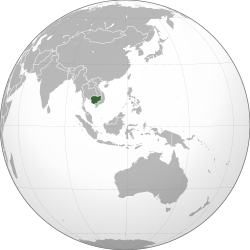Kingdom of Cambodia (1953–1970)
| Kingdom of Cambodia | ||||||||||
| ព្រះរាជាណាចក្រកម្ពុជា Preăh Réachéanachâk Kâmpŭchéa Royaume du Cambodge |
||||||||||
|
||||||||||
|
||||||||||
|
Anthem Nokor Reach បទនគររាជ "Royal Kingdom" |
||||||||||
| Capital | Phnom Penh | |||||||||
| Languages | Khmer | |||||||||
| Religion | Buddhism | |||||||||
| Government | Dominant-party constitutional monarchy |
|||||||||
| King | ||||||||||
| • | 1953–1955 | Norodom Sihanouk | ||||||||
| • | 1955–1960 | Norodom Suramarit | ||||||||
| Head of State | ||||||||||
| • | 1960 | Chuop Hell | ||||||||
| • | 1960 | Sisowath Monireth | ||||||||
| • | 1960 | Chuop Hell | ||||||||
| • | 1960–1970 | Norodom Sihanouk | ||||||||
| • | 1970 | Cheng Heng | ||||||||
| Prime Minister | ||||||||||
| • | 1953 | Penn Nouth (first) | ||||||||
| • | 1969–1970 | Lon Nol (last) | ||||||||
| Legislature | Parliament | |||||||||
| Historical era | Cold War | |||||||||
| • | Independence | 9 November 1953 | ||||||||
| • | Creation of Sangkum | 22 March 1955 | ||||||||
| • | Coup d'etat | 18 March 1970 | ||||||||
| • | Republic proclaimed | 9 October 1970 | ||||||||
| Area | 181,035 km² (69,898 sq mi) | |||||||||
| Population | ||||||||||
| • | 1962 est. | 5,728,771 | ||||||||
| Currency | Riel | |||||||||
|
||||||||||
| Today part of |
|
|||||||||
The Kingdom of Cambodia (Khmer: ព្រះរាជាណាចក្រកម្ពុជា, French: Royaume du Cambodge), informally known as the first Kingdom of Cambodia (Khmer: ព្រះរាជាណាចក្រកម្ពុជាទី ១) and the Sangkum Reastr Niyum era (Khmer: សម័យសង្គមរាស្ត្រនិយម "People's Socialist Community", French: Communauté socialiste populaire), referred to Norodom Sihanouk's first administration of Cambodia from 1953 to 1970, an especially significant time in the country's history. Sihanouk continues to be one of the most controversial figures in Southeast Asia's turbulent and often tragic postwar history.
Although Cambodia had achieved independence by late 1953, its military situation remained unsettled. Noncommunist factions of the Khmer Issarak had joined the government, but pro-communist Viet Minh and United Issarak Front activities increased at the very time French Union forces were stretched thin elsewhere. In April 1954, several Viet Minh battalions crossed the border into Cambodia. Royalist forces engaged them but could not force their complete withdrawal. In part, the communists were attempting to strengthen their bargaining position at the Geneva Conference that had been scheduled to begin in late April.
The Geneva Conference was attended by representatives of Cambodia, North Vietnam, the Associated State of Vietnam (the predecessor of the Republic of Vietnam, or South Vietnam), Laos, the People's Republic of China, the Soviet Union, France, Britain, and the United States. One goal of the conference was to restore a lasting peace in Indochina. The discussions on Indochina began on May 8, 1954. The North Vietnamese attempted to get representation for the resistance government that had been established in the south, but failed. On July 21, 1954, the conference reached an agreement calling for a cessation of hostilities in Indochina. With respect to Cambodia, the agreement stipulated that all Viet Minh military forces be withdrawn within ninety days and that Cambodian resistance forces be demobilized within thirty days. In a separate agreement signed by the Cambodian representative, the French and the Viet Minh agreed to withdraw all forces from Cambodian soil by October 1954.
...
Wikipedia



